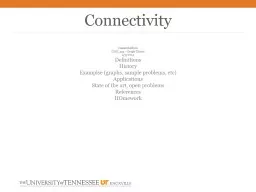PPT-Daniel Baldwin
Author : sherrill-nordquist | Published Date : 2016-09-19
COSC 494 Graph Theory 492014 Definitions History Examplse graphs sample problems etc Applications State of the art open problems References HOmework Connectivity
Presentation Embed Code
Download Presentation
Download Presentation The PPT/PDF document "Daniel Baldwin" is the property of its rightful owner. Permission is granted to download and print the materials on this website for personal, non-commercial use only, and to display it on your personal computer provided you do not modify the materials and that you retain all copyright notices contained in the materials. By downloading content from our website, you accept the terms of this agreement.
Daniel Baldwin: Transcript
Download Rules Of Document
"Daniel Baldwin"The content belongs to its owner. You may download and print it for personal use, without modification, and keep all copyright notices. By downloading, you agree to these terms.
Related Documents














